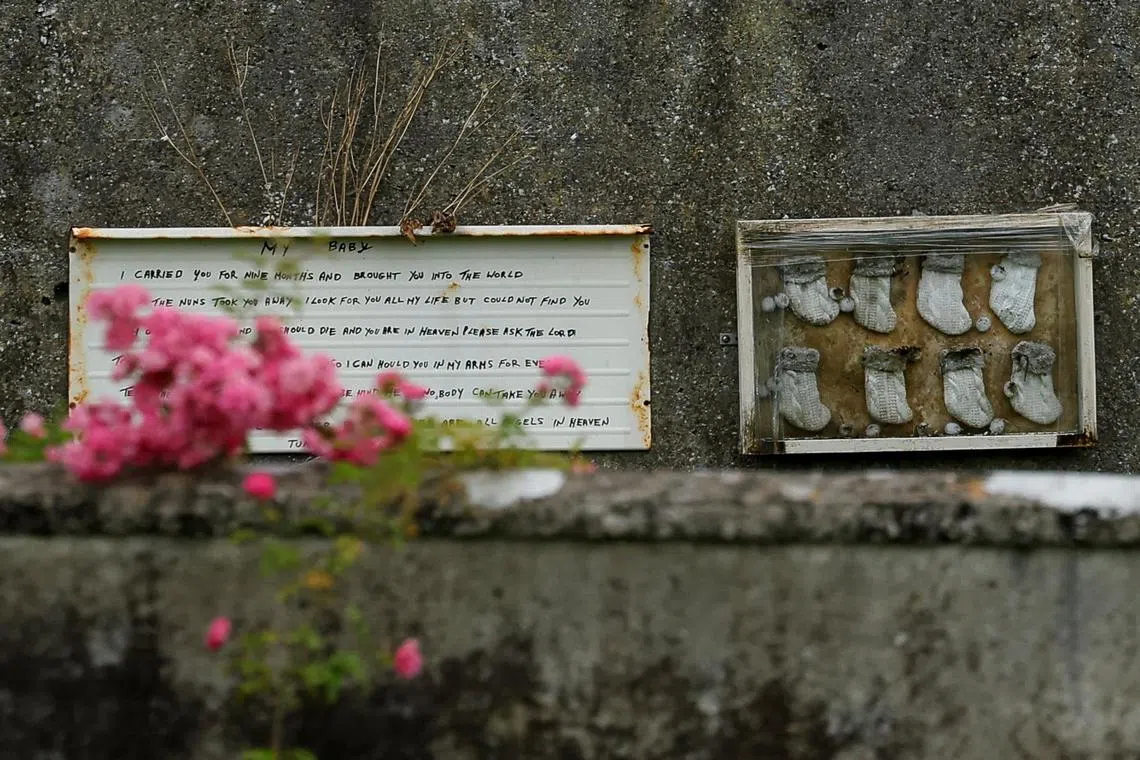‘Take the babies out of sewage system’: Excavations begin at mass child grave site in Ireland
Sign up now: Get ST's newsletters delivered to your inbox

A memorial at the Tuam graveyard in Ireland. Records show as many as 796 babies and young children died at the Tuam home.
PHOTO: REUTERS
Follow topic:
DUBLIN – Excavations at an unmarked mass burial site are expected to start on July 14 in a former mother and baby home in western Ireland.
The site is suspected of containing the remains of hundreds of infants and young children.
The planned two-year probe by Irish and foreign experts in Tuam, a town located north of Galway, comes more than a decade after an amateur historian first uncovered evidence of a mass grave there.
Subsequent test excavations in 2016 to 2017 found significant quantities of baby remains in a subterranean disused septic tank at the location, which now sits within a housing complex.
Catholic nuns ran a so-called “mother and baby” institution there between 1925 and 1961, housing women who had become pregnant outside of marriage and were shunned by their families.
After giving birth, some children lived in the homes too but many more were given up for adoption under a system that often saw the church and state work in tandem.
Oppressive and misogynistic, the institutions – which operated nationwide, some not closing until as recently as 1998 – represent a dark chapter in the history of the once overwhelmingly Catholic and socially conservative Ireland.
A six-year inquiry sparked by the initial discoveries in Tuam found that 56,000 unmarried women and 57,000 children passed through 18 such homes over a 76-year period.
It also concluded that 9,000 children had died in the various state and Catholic Church-run homes nationwide.
Records unearthed show as many as 796 babies and young children died at the Tuam home over the decades that it operated.
Its grounds have been left largely untouched after the institution was knocked down in 1972 and housing was built there.
A fierce battle
Ms Anna Corrigan, whose two siblings may have been buried at the Tuam site, spoke to reporters earlier in July. She said: “These children were denied every human right in their lifetime, as were their mothers.
“And they were denied dignity and respect in death.”
Ireland’s Office of the Director of Authorised Intervention (Odait) will undertake the excavation, alongside experts from Colombia, Spain, Britain, Canada and the United States.
It will involve exhumation, analysis, identification if possible, and re-interment of the remains found, said Odait director Daniel MacSweeney at a press briefing in Tuam.
In 2014, local historian Catherine Corless produced evidence that the 796 children – from newborns to a nine-year-old – had died at the home.
State-issued death certificates she compiled show that various ailments, from tuberculosis and convulsions to measles and whooping cough, were listed as the cause of death.
Ms Corless’s research indicated the corpses were likely placed in the disused septic tank discovered in 1975, while prompting the state-backed inquiries that have uncovered the full scandal of the homes.
The Odait team was finally appointed in 2023 to lead the Tuam site excavation.
DNA samples have already been collected from about 30 relatives, and this process will be expanded in the coming months to gather as much genetic evidence as possible, said Mr MacSweeney.
A 2.4m high hoarding has been installed around the perimeter of the excavation area, which is also subject to 24-hour security monitoring to ensure its forensic integrity.
In May, Ms Corless, 71, said: “It’s been a fierce battle. When I started this, nobody wanted to listen. At last, we are righting the wrongs. I was just begging: ‘Take the babies out of this sewage system and give them the decent Christian burial that they were denied.’”

